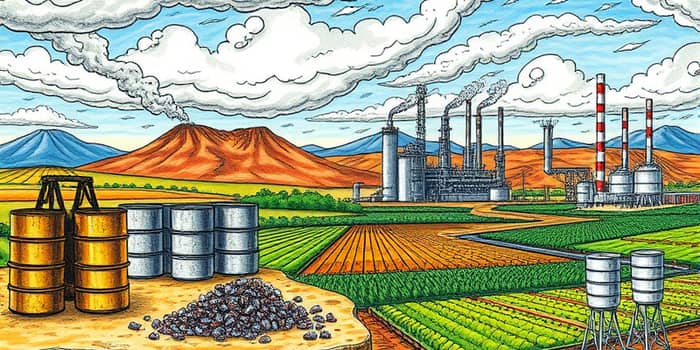
As global economies recalibrate after post-pandemic rebounds, commodity markets are poised for a period of adjustment. Investors, producers, and policymakers must navigate a landscape shaped by shifting demand, oversupplied energy markets, and evolving regulatory pressures.
The World Bank projects that global commodity prices are set to decline by 12% in 2025 and a further 5% in 2026, bringing real prices below the 2015–2019 average for the first time in years. This reversal follows strong gains in 2021–2023, driven by supply disruptions and robust demand.
Key forces behind this downturn include slower global economic growth and oversupplied oil markets. Even sectors like fertilizers and precious metals, which showed momentary resilience in early 2025, are unlikely to escape the broad-based pressure.
Energy commodities are set to experience the most pronounced declines. After peaking in 2022 and 2023, oil and gas markets face headwinds from both supply and demand sides.
In the oil sector, Brent crude is expected to average $64 per barrel in 2025 (down $17 from 2024) and settle near $60 in 2026. Alternate forecasts from J.P. Morgan place averages at $66 and $58 per barrel, respectively. Growth in electric vehicles—from 15% of new car sales in China in 2021 to over 40% today—has eroded incremental demand.
On the supply side, OPEC producers plan to ramp up output by 411,000 barrels per day in June 2025, while non-OPEC contributors such as the UAE (+200,000 bpd annually) and Kazakhstan (+200,000 bpd at Tengiz) further add to global inventories. Iraq, Kuwait, and the Saudi-Kuwaiti Neutral Zone are also nudging capacity upward.
Natural gas markets are likewise tightening supply thresholds. The U.S. Henry Hub spot price is forecast to average $4.00 per MMBtu in 2025 and climb to $4.90 in 2026. Rising gas costs will, in turn, lift U.S. electricity prices by an estimated 4% in summer 2025 compared to last year.
Coal production in the U.S. remains stable near 506 million short tons in 2025 before declining to 475 million in 2026. Policymakers pushing for decarbonization and increased renewables adoption continue to weigh heavily on coal demand.
Renewable energy exhibits mixed signals. The U.S. solar industry installed a record 9.4 GW (DC) in Q2 2024, with utility-scale capacity additions averaging 31 GW annually over the last five years. Yet rising interest rates, labor shortages, and grid interconnection delays have created headwinds, while module prices dropped roughly 40% year-over-year.
Following a 2.5% price increase in 2024, industrial metals are forecast to moderate through 2025–26. April 2025 saw a 7% decline in core industrial metal prices as a maturing supply pipeline met tepid demand.
Precious metals have provided temporary refuge in early 2025, buoyed by safe-haven investor flows. However, this support will likely prove fleeting if broader economic activity softens further. Supply chain challenges driven by trade tensions and tariff policy shifts remain persistent risk factors.
Agricultural markets are similarly set for gradual declines. Food prices eased in early 2025, even as beverages pushed marginally higher. Overall, agriculture is forecast to fall 1% in 2025 and 3% in 2026.
Weather-related risks, such as drought impacting Panama Canal traffic, have heightened volatility in grain shipments. Logistical challenges and shifting dietary trends in major markets like China further influence pricing dynamics.
The global chemical sector is experiencing a robust rebound after minimal growth in 2023. Production volumes are projected to expand 3.4% in 2024 and another 3.5% in 2025, reflecting improved demand from manufacturing and construction segments.
Despite margin improvements, companies confront several challenges: macroeconomic uncertainty, evolving emissions regulations (e.g., Europe’s Corporate Sustainability Reporting Directive), and geopolitical disruptions such as Russian gas supply cuts and Red Sea shipping threats.
Supply chain agility and compliance have emerged as strategic priorities, while digital tools for real-time pricing and disruption tracking are gaining traction across over 300 chemical products.
Across commodity groups, several overarching risks warrant close monitoring. Geopolitical tensions and shifting regulatory frameworks continue to reshape trade flows and investment strategies.
Key assumptions for forecasts include moderate global growth, stable monetary policies, and no major geopolitical shocks beyond current projections. Any departure—such as accelerated decoupling of China energy demand or unexpected OPEC policy changes—could materially alter these outlooks.
After years of elevated volatility and multi-year price rallies, commodity markets are entering a phase of normalization. Energy prices face the steepest declines, while metals, agriculture, and chemicals adjust to rebalanced supply and softening demand.
For investors and policymakers, the period ahead offers both risks and opportunities. Cost reductions in renewables and chemical digitalization suggest areas for strategic investment, even as traditional sectors recalibrate. Vigilant monitoring of geopolitical events, regulatory shifts, and technological breakthroughs will be crucial for navigating this evolving landscape.
References













